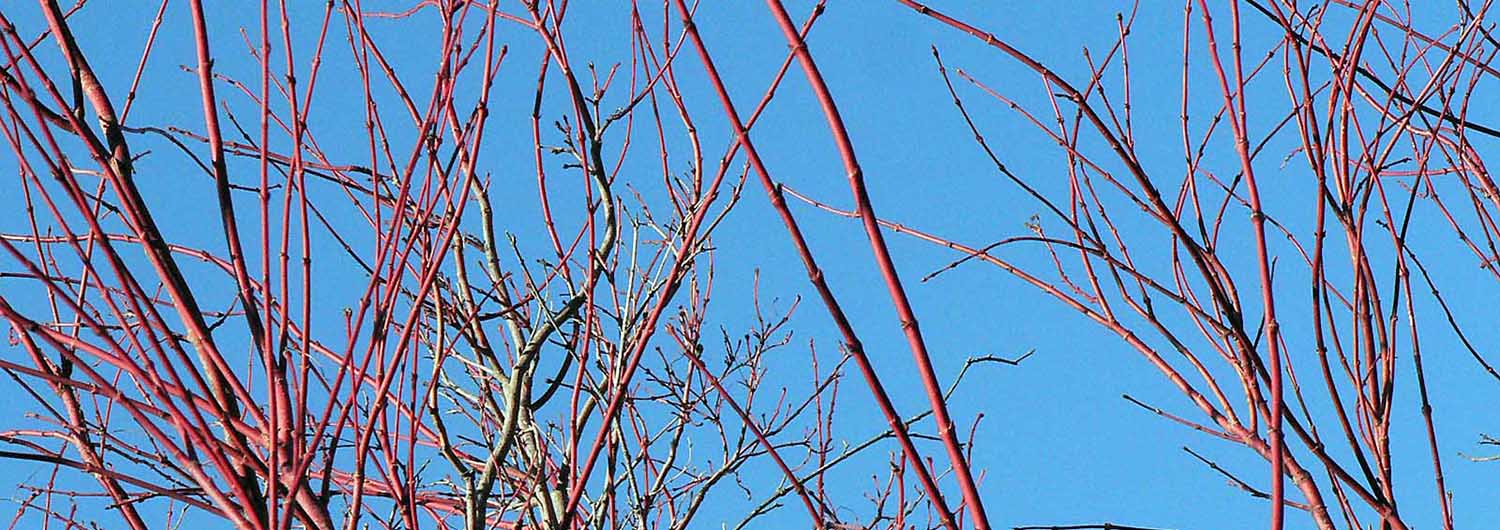Acer palmatum 'Sango kaku'
Japanese maple
In contemplating sources of color for the southern winter garden, we generally first conjure visions of winter flowering shrubs, or bright-foliaged conifers subtended with drifts of the earliest blooming bulbs. But there is another fascinating and diverse source of winter color to add to these more traditional venues, and that is the bark of woody plants. There are hundreds of trees, shrubs and vines with beautiful barks in a surprising palette of hues and textures. One of these that is especially breathtaking in winter is the silken coral color of the bark of Acer palmatum 'Sango kaku', the coral bark maple.
'Sango kaku' is a cultivar of the familiar Japanese maple, Acer palmatum, which was selected in Japan primarily for its brilliant, coral-red bark winter coloration. During cold weather the bark color intensifies to an almost fluorescent, salmon. 'Sango kaku' is a dramatic feature in the winter landscape with its bare trunk stretching glowing pink limbs up against the dark greens and grays of other trees. The growth habit is more upright and elongated than many other Japanese maple selections which heightens the impression that a color-starved artist had brushed bright strokes in graceful vertical lines through the garden. While winter is considered the peak season of interest for 'Sango kaku' because its bark is brightest then, it is quite lovely in all four seasons of the year. Like many Japanese maples, this cultivar's leaves emerge tinged with bright red in the spring and then turn a uniformly pleasing jade-green for the summer. In the fall, the foliage turns yellow gold with burnished overtones and makes a wonderful contrast with the coral bark as it begins to intensify toward its winter depth of color.
Japanese maples in general are good, tough plants for the Southeast that bring great beauty to the landscape year-round. The many forms range from 2'–3' tall dwarf varieties to 30' tall specimens with magnificent architectural branching supporting a 30' crown. They are native to eastern Asia and prefer a moist, loamy soil but will happily thrive in a range of soil conditions from sand to heavy clay. They will perform well from full sun to relatively dense shade with no significant disease or pest problems and are quite tolerant of dry periods. Full sun will generally give best color development and the most compact and dense habit. Japanese maples tend to be greener and a bit more open and stretched in the shade but they are elegant and beautiful in any site. 'Sango kaku' will generally have the boldest bark color if grown in the sun and on the youngest, most vigorous growth, but even older plants develop striking color in winter.
The small, refined, palm-shaped leaves of Japanese maple are veritable horticultural icons and the myriad of Japanese maple cultivars play many interesting variations on that familiar visual theme. Cultivars with blood-red, white-variegated, curled, twisted, highly divided and nearly nonexistent foliage are among the many forms available but none can compete with 'Sango kaku' for winter color. There is another cultivar called 'Corallinum' that also has salmon-hued bark but it was named for its coral colored spring foliage with the bark as a secondary interest and its bark color is not as intense as 'Sango kaku'. Like most named forms of Japanese maple, 'Sango kaku' and 'Corallinum' are propagated by grafting young branches of the cultivar onto seedling rootstock in winter. Japanese maple can be propagated by rooted cuttings but it is a difficult and a slow process.
'Sango kaku' is sometimes mistakenly called 'Corallinum' (and vice-versa) but they are very different plants. 'Sango kaku' is also seen occasionally with the names 'Senkaki', 'Coral Tower', or 'Cinnabar Wood Maple', but these names are synonyms for 'Sango kaku' which is the most common and correct name. The many Japanese names of all of the cultivars of Acer palmatum, and related species (like A. japonicum, full moon maple) can be a nightmare for the uninitiated to sort out. The standard reference, Japanese Maples, by the renowned expert J.D. Vertrees, (published by Timber Press) is not only an excellent reference but an accessible, practical help.
At the NCSU Arboretum, Acer palmatum is the symbol of the Arboretum because of its great beauty and durability, four season interest, and well-adapted performance in the Southeast. Many different Japanese maples are planted throughout the Arboretum, including a number of 'Sango kaku' trees. In the Winter Garden, and along the vine lattice, coral-bark Japanese maples create spectacular horticultural art in combination with all the different colors and forms of the winter landscape. Their flash of coral leaps to the eye like tropical fish flashing over a reef—a welcome brilliance in the garden, and an incomparable framework for the flowers and foliage of other winter-interest plants. Plant 'Sango kaku' Japanese maple to paint your own winter garden with bold and elegant strokes.

